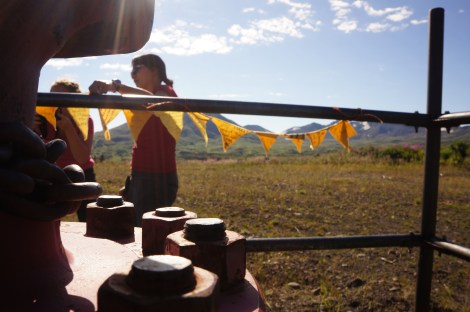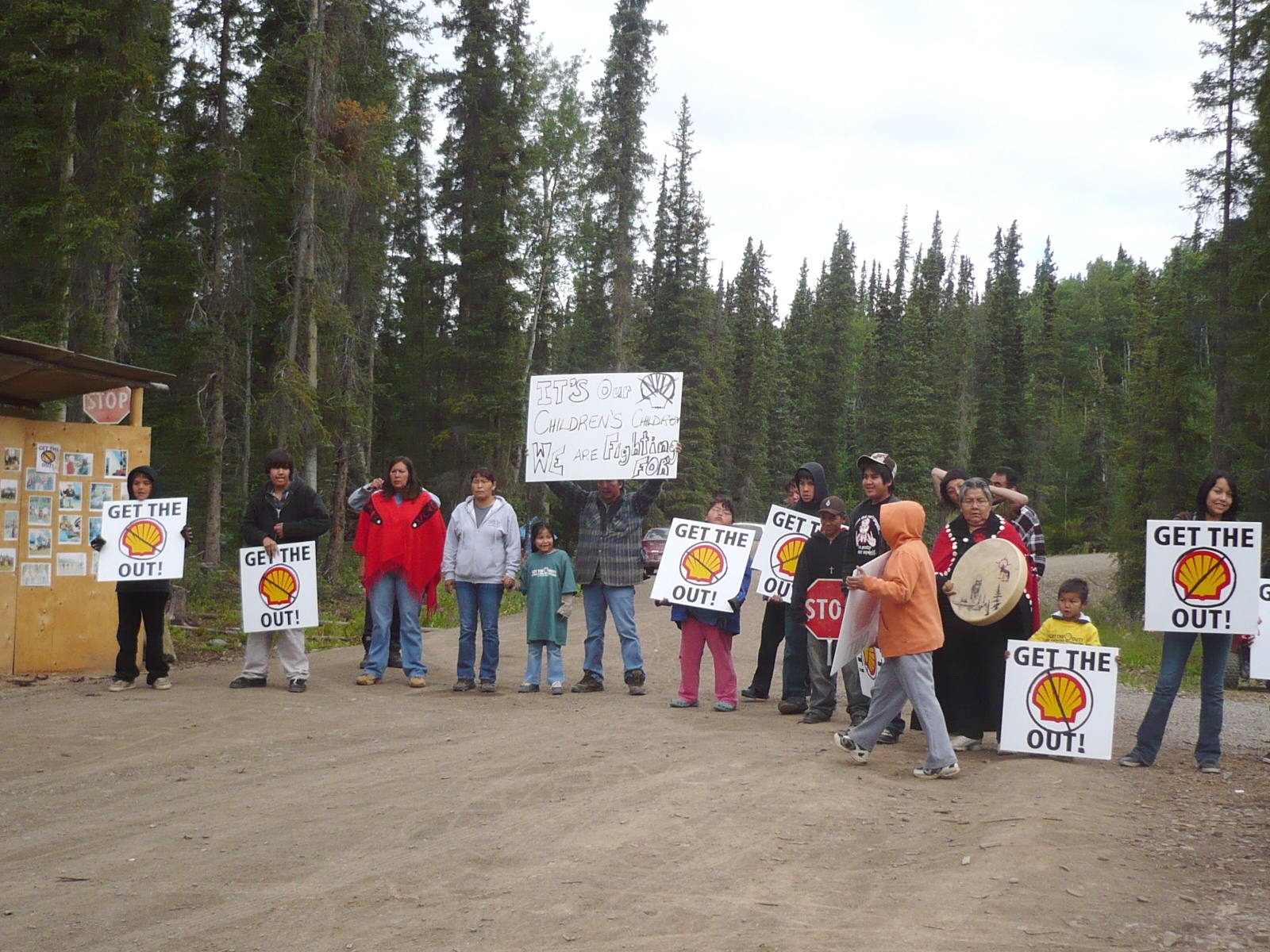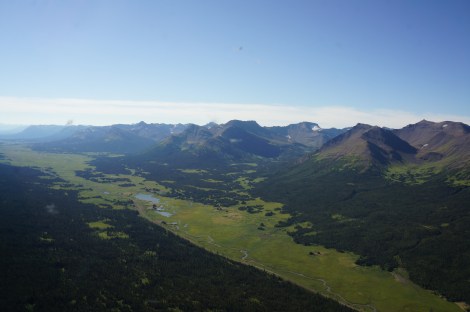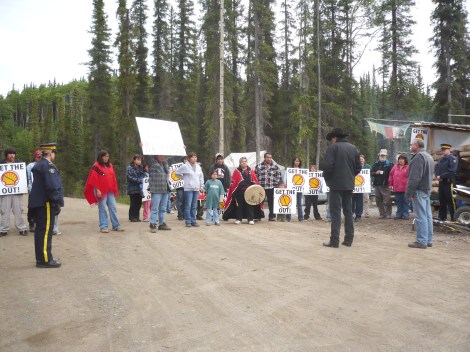Editor’s note: This is part 2 of Grist’s series on the Sacred Headwaters. Read part 1 here and part 3 here.
Our gruff Kiwi pilot lands the chopper at one of the three decommissioned Shell test wells set for removal, just a few ridges over from the headwaters. I’m taken a bit aback at first: Somehow, I thought they’d be taller. Instead, it resembles a fire hydrant propped up a few extra feet, circled by a metal bar fence that reminds me of a city bike rack. A Shell Canada sign is plastered with “Get the Shell Out” and “Save Our Salmon” stickers. Electric pink fireweed creeps down from the snowcapped peaks in the background, intruding on the flattened dirt pad left over from installation. It’s August 2013, and the wells won’t be removed for another two months, but the vegetation seems impatient.

Join Grist for an exploration of recent climate wins. This is a guarded, cautiously optimistic thumbs up, mind you.
I’m along for the ride with Karen Tam Wu and Melyssa Desilles-Rubino, representatives from ForestEthics, a Vancouver-based NGO that threw its weight behind the Sacred Headwaters in 2007 when they learned of Tahltan and SWCC’s stand against the second largest company in the world. Over five years, they engineered a plan to get the word out and draw international support, mostly with stunts by turns audacious and zany: Buying full-page protest ads in the Financial Times; hounding Royal Dutch Shell CEO Peter Voser across the globe to present him with a dead salmon trophy; hiring Santa to deliver coal to Shell headquarters; stringing 50-foot-long banner of 60,000 signatures (rendered in 10-point font) in opposition at Shell Canada headquarters in Calgary.
Desilles-Rubino and Tam Wu are here to leave a parting gift for Shell. They string fluttering pennant flags on the surrounding fence; each flag has a handwritten message from ForestEthics volunteers — things like “thank you for keeping this land sacred” and “this land belongs to salmon.” Just before, our pilot barked that we only had a few minutes. The wind-whipping blades aren’t making things easy, so Desilles-Rubino and Tam Wu tie and retie a few times to get it just right.

Ted AlvarezString theory: Tam Wu and Desilles-Rubino leave a message of thanks for Shell.
“Local communities were quite diverse in their opinions of coal-bed methane, but the SWCC and the Tahltan did a ton of work in the first few years to raise public awareness by turning a blockade into a drive to save the Sacred Headwaters,” Tam Wu says later. “That spread downstream and grew to several thousand people. But you saw how big it was up there — it could’ve fizzled if they didn’t spread the word. But it became a provincial and an international story. Shell thought ‘no one has heard of this place and we’ll be able to do what we want.’ But the fight reaffirmed the value of salmon. When salmon is under threat, communities will come out fighting.”
Once the gift is secure, we all scan over the serrated horizon for a few last looks.
“I’m just overwhelmed by the beauty of this place; I’ve got goosebumps,” Desilles-Rubino says. “To see wells in this place, a place that’s still so wild — and I’m so relieved [the wells] will be gone soon.”
“Isn’t it spectacular?” she asks me over the whup-whupping. “I just want to go roll around in it.”
I most certainly do not want to go roll around in it. Mostly because I’ve spent the last five days doing just that across the trackless Spatsizi Provincial Park — getting torn at and tangled in buck brush thickets, stumbling through frozen rivers, and undergoing half-dialysis via mosquito cloud. That fireweed already seems to be saying, “don’t fuck with me, bub.” The landscape itself seems poised to swallow all foreign invaders. That piddling well doesn’t really stand a chance.
I know that isn’t true, but luckily for the north country, steely self-defense is in the water — and Northern B.C.ers drink deep.
“Somebody once said the Skeena has an immune response system,” Skeena Watershed Conservation Coalition Director Shannon McPhail says. “Whether it’s Enbridge, Shell, or fish farms [with nonnative species] — they engulf the foreign invader, chew them up, and shit them out. But not unless we’re all working together. We did 200 community presentations, but we didn’t say ‘you need to vote and oppose it.’ It was: Coalbed methane 101; what are the risks, what are the benefits, where is it being proposed; why they’re chasing it so hard.”
Skeena Watershed made presentations at rod and gun clubs, the various chambers of commerce, and local businesses. They encouraged each to have Shell come present as well. Nearly all signed formal resolutions against coalbed methane.
“We just armed them with knowledge — we didn’t make huge claims,” she said. All they need to do is catch us in one inflamed statement and we have no credibility.”
Rhoda Quock is a Tahltan tribe member from Iskut. She helped begin the blockade on July 15, 2005, after Fortune Minerals contacted her husband, Peter Jakesta, a heavy-equipment operator, to help clear a site in the Sacred Headwaters. The site just happened to be the ancestral hunting grounds of her father — a scenic meadow spread before Mount Klappan and known to most as Beauty Camp.
“We’ve been here forever,” Quock says of Tahltan presence in the area. “When we heard my late father Barry Quock’s camp was going to be a tailings pond, that’s when we got involved. We hunted and fished there every summer.”
Unbeknownst to Fortune, Jakesta was committed to protecting the Sacred Headwaters. Quock immediately left for Beauty Camp, bringing her 4-year-old daughter and 1-year-old son. They alerted key elders to join them, and her husband stopped the first tractor-trailer bound for the Headwaters with drilling equipment. Oscar Dennis, a Tahltan elder, drew a line in the dirt with his boot and called for the driver.
“The people negotiating for this land do not represent us,” Jakesta said while holding his daughter, according to Davis’ book. “We are blocking this road.”
This act was just one of the sparks that united the Tahltan communities of Iskut, Telegraph Creek, and Dease Lake against the few Tahltans who negotiated with Shell, Fortune, and other extractive interests. The first came when former Telegraph Creek Band Chief P. Jerry Asp, who founded the mining-friendly Tahltan Nation Development Corporation, drew support from other off-reserve Tahltans to negotiate and accept fees to allow mining and drilling in lands they largely didn’t visit, hunt, or fish on. And while many believe extractive industries can be a future source of employment for the community, Tahltan elders sought to reassert control over their tribe and side with fish and food first over gold and coal. So just before the blockade, they staged an eight-month sit-in in the chief’s offices in Telegraph Creek. As Tahltan August Brown said: “I have a message I want to get to the mines. We cannot eat gold. We can eat our animals and fish.”
The sit-ins and blockades revitalized the Tahltan community, breathing new life into traditional values and healing old wounds between the occasionally contentious communities of Dease Lake, Iskut, and Telegraph Creek. (The Walrus features an in-depth exploration of Tahltan politics and a blow-by-blow of the sit-in.)
“We’re more united now than we were back in 2005,” Quock says. “The majority of the Talhltan are on the same page. We actually have a young guy, he’s probably around 19 or 20, who actually refused to go back up to work for Fortune Minerals because of the fight. He told them ‘no, that’s my people.’”
The blockade lasted into the summer, and as more Tahltan arrived, the tribe erected walled tents painted with sacred band symbols like Crow and Wolf. The protest turned to celebration, with stories and songs told around the fire by elders and food catered by the villages. Great-grandparents turned up in wheelchairs. Nature and circumstance contributed in eerie and auspicious ways, as when moose or caribou wandered nearby when food ran low. During the July salmon run, folks waiting in the blockade began to worry about losing their chance to stock up on food for winter. But then a tractor-trailer full of Alaskan salmon wrecked 10 minutes away, spilling hundreds of fish. With spoilage imminent, blockaders built drying racks and smoked salmon in the growing camp. The blockaders turned away industry and development, but welcomed outsiders and locals alike who’ve come to recreate and appreciate the land with respect.
The blockade wasn’t all sunshine and good feeling. Quock’s husband had worked for Shell in the past and lost a prospective employer; Quock herself missed the beginning of the school year while on the blockade and had to forfeit her job.
“I chose to continue with the fight into October, so I gave up my job, and we struggled after that,” Quock says. “But it is very worth it. I have four kids — two 18 year-olds, a 12-year-old, and one 9-year old. Hopefully, I don’t have to tell them much (about this fight) because they lived it. They know the risk of losing the land.”
Finally, in August 2005, a small breakthrough: In response to the blockade and the associated sit-in by elders in the Tahltan Central Council office in the Tahltan community of Dease Lake, Shell temporarily chose to suspend operations in the Klappan of its own volition. Despite working out a deal with Tahltan’s nominal leaders, Shell learned the Tahltan people at large had other ideas.
“In Iskut and Telegraph creek, in 2005 there were other politics at play, internal things they needed to work through,” says Larry Lalonde, communications manager for Shell Canada. “So we took the decision to pause for more discussion. And we did some repairs to the road and we used some Tahltan employment to help do that.”
Fortune Minerals was more tenacious. Advocates obtained an injunction against the blockaders for keeping out a mining crew, and on Sept. 16, 15 were arrested. Delegations from other First Nations — including the Haida, Gitxsan, and Wet’suwet’en — arrived in full traditional dress to lend support as Royal Canadian Mounted Police removed the protesters to Dease Lake.
But even in the earliest battles, wind and momentum had begun to shift. Fortune Minerals dropped charges three days before their court hearing. First Nations across Canada signed declarations of unity and solidarity. Tahltan feats of heroism — like the 73-year-old great-grandmother who went to jail smiling, or the elderly hunter who loaded up on painkillers and headed bravely into the clink — lit a fire within the outer community.
Protests against Shell and Fortune Minerals spread across Northern B.C.
The provincial government eventually issued a four-year pause on Shell’s drilling plans for the area, but the tension wouldn’t release. So natives and nonnative residents dug in their heels and threw potlucks, town rallies, and bar-stool debates. Long-distance swimmer Ali Howard spent 28 days swimming the 379-mile Skeena River from headwaters to ocean, becoming the first to tackle the entirety of B.C.’s second-longest river. She made a film and toured the U.S. and Canada to drum up support. “Get the Shell Out” stickers shone on pipefitters’ hard hats in the Alberta tar sands.
Outside the community, ForestEthics used PR voodoo to monkey wrench international eyes into watching; inside, the tight-knit band of fishermen, welders, hunters, loggers, and stolid Tahltan simultaneously sharpened their defenses and threw open their doors.
Santa delivers coal to Shell headquarters. [Courtesy ForestEthics]
And then something familiar to pipeline watchers south of the border crept in, thick and slow as river mud. Waiting. Limbo. Purgatory.
Next: Looking for lessons and confronting uncertainty in the Sacred Headwaters’ future.






